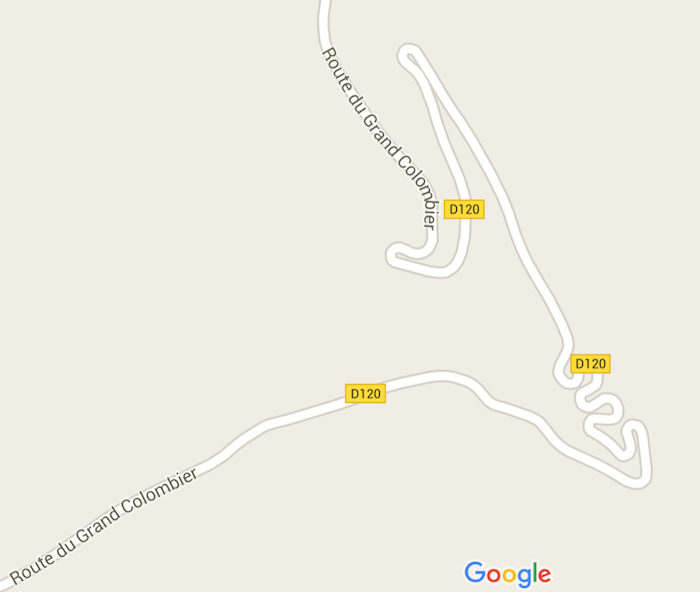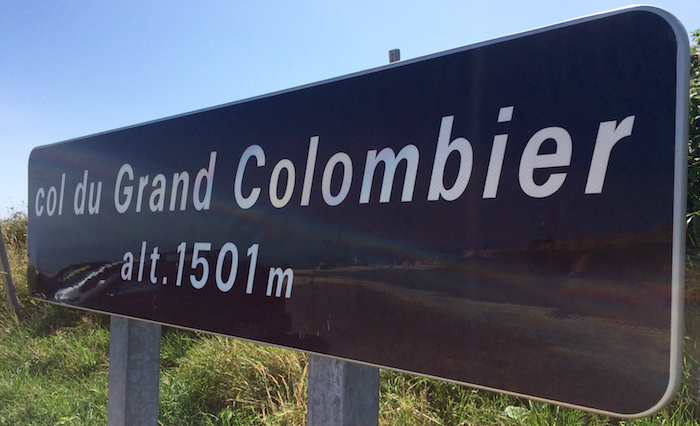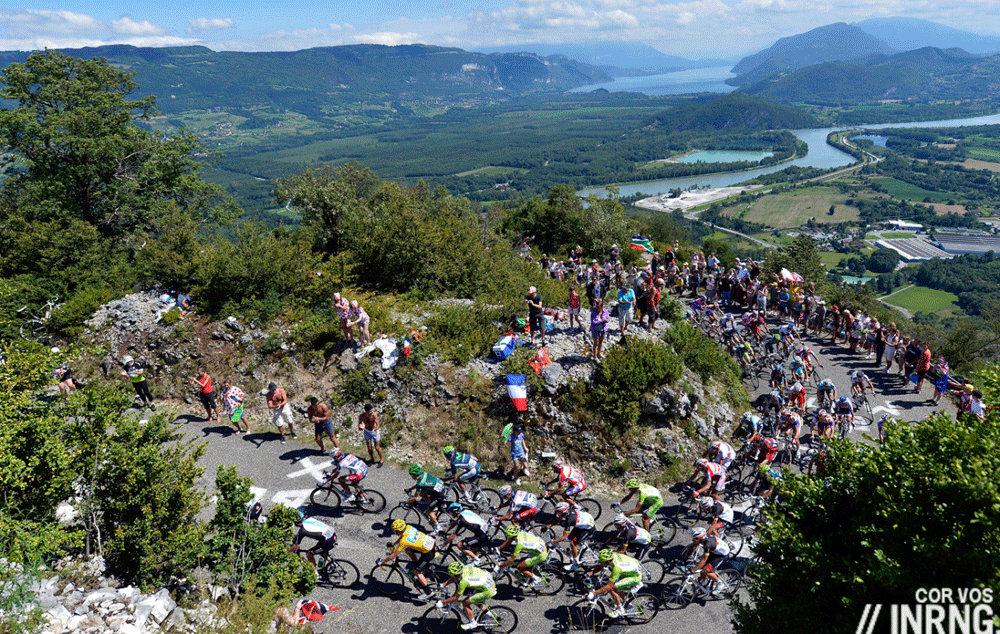Back in the Tour de France for only the second time the Grand Colombier is an unheralded climb that offers a physical test and then rewards with impressive views.
 The Route: there are several ways to the top. Like Mont Ventoux there is a single road over the top but there are different approaches. This piece looks at the climb from Culoz via the lacets or hairpins. The D120 is 18.3km long and averages 6.9%.
The Route: there are several ways to the top. Like Mont Ventoux there is a single road over the top but there are different approaches. This piece looks at the climb from Culoz via the lacets or hairpins. The D120 is 18.3km long and averages 6.9%.
The Feel: The start in Culoz isn’t promising. There’s little of interest in the town, the kind of place where people are drinking beers in the morning and it took several laps of the town to find a bakery for a pre-ride croissant. It’s half-famous as the home town of Christophe Lemaitre, the 100m/200m specialist in athletics. Perhaps he saw Culoz and wanted to get out quick? Certainly running is easier than climbing the Grand Colombier: the road starts steep. The mountain dominates the town with its cliff faces, look up and you can see a diagonal line scratched across the cliff face: that’s road you’ll be on soon.
Because it’s steep you gain height fast. First past suburban houses, then through the vineyards and soon you see the Rhone valley and the Lac du Bourget, France’s largest lake, and beyond it the Alps. It’s a view that’s part breathtaking, part geography lesson. The road edges along the cliffs to the soon-to-be famous lacets.

These bends are odd, they wind up around a promontory of rock, almost like a tower in the corner of a castle where you ride up a spiral staircase to the ramparts. As magical as this sounds it’s just steep and twisty but stop at the right place and the views invite you to linger and watch the world below go by.
Online forums often mention the heat. The first part of the climb is south-facing and parts of it have a rock wall to radiate the heat back at you but most of the climb is shaded, press on through the exposed part and you’ll find it easier in the woodland. Once past the famous hairpins the slope eases until you pass the route joining from the south, soon after the road switches back in the opposite direction and the road rears up, more 10-12% sections await before the next hairpin marks where the slope eases.
Higher up and the road crosses a cattle grid and enters the final open section and there’s a steady gradient to the top with pastures and views of the Rhone valley below.

Summary: steep, irregular and a mix of roads, first the quick escape out of a scruffy town, then stunning views of the Rhone and Alps before long straight sections though shaded woodland and the final section reaching the open summit and more rewarding views. Be sure to try it on a clear, sunny day.
Ride more: reach the top, enjoy the views and then you can descend the other side. When you reach the fork it’s wiser to descent to Lochieu, it’s still steep but take the left turn to Virieu and you’ve got some 20% sections. Other options include the sister climb of the Col de la Biche, almost as hard or loop back south to ride around Lake Bourget and pick off as many climbs or as little of the climbs near the lake as you want.
The Tour: They’ll race up the other side, drop down before taking the valley road around to Culoz, cross the finish line and then tackle the steep part of the climb and the lacets section before rejoining the already used descent and valley road to the finish. The long climb is not as steep but can still be used for attacks. On paper it looks suited to punchy riders, the stage has something of Liège-Bastogne-Liège about it although the Grand Colombier is much longer than anything in the Ardennes. On paper it’s got the vertical gain of the Galibier but not the altitude.

History: climbed only once in the 2012 Tour de France it led to nothing because it was some way from the finish. However this has been the decisive climb of the Tour de l’Ain stage race every August for many years and for years on end David Moncoutié seemed to win again and again.
Jura: as in Jurassic and not the Alps. This is a mountain range north of the Alps. Look at the picture above and the mass of white peaks are the Alps, to the north you can make out some green crinkled ridges, these are the Jura mountains. They’re scenic with river canyons and cliffs and totally off the radar with no races to speak of nor much else. See how the Jura arcs round to the South? The Grand Colombier is almost at the end of this.
Travel and access: Aix-les-Bains makes a good base with rail and road access and plenty of roads to ride in the area included the fearsome Mont du Chat and also Mont Revard and access to the Alpine climbs.
More roads to ride at inrng.com/roads


Glad this climb is back, helicopter shots of the peloton snaking through the lacets in 2012 was spectacular. “Because it’s steep you gain height fast” is good stuff too. Thanks for braving Culoz…with your nous you just knew there had to be a croissant for sale there somewhere!
One day i’d love to see the Tour climb first “Mont du Chat” (from le Bourget) then tackle the Grand Colombier via la Directissime (http://www.felesducolombier.fr/index.php/pour-devenir-feles/les-pentes, search “Directissime” on the page)
I like to climb from Culoz and make the downhill on the same side to take a rest at “Les Portes” (the serie of small hairpins in the rocks). You have this view on a sunny day: Google Maps link
If you go there for some holidays, don’t miss the short but very steep climb of “La Chambotte” (5kms, 8.3% avg : http://www.cols-cyclisme.com/jura/france/col-de-la-chambotte-depuis-chindrieux-c871.htm) from Chindrieux (and enjoy some local wine) and stop on the only hairpin few meters from the summit. You have also a stunning view with the Grand Colombier in the background:
Google Maps link
Chambotte makes for a very scenic loop with Col du Clergeon, and/or Col du Sapenay ….. directly across from Grand Colombier
If only my legs were still young enough to go have a crack
what a magnificent climb this is great to see it back on the route
Inring thanks for your insight as usual superb
With modern gears, why not? Taking your time in a nice low 34/36 is readily attainable by most folks who can pedal a bike. Gone are the days when you had to struggle on a 42/23! One of the upsides of moder bike tech…
Why settle for just a 34/36 – unless you meant in back? 🙂 I’m skeptical of a lot of what passes for “modern bike tech” these days but gearing has truly evolved for the better, much better. I’m bemused as to why triple setups are not more popular. The modern ones give the rider everything he or she enjoys with any sort of double + very low gears for monster climbs via that 30 tooth ring up front. All of the old complaints have been pretty much dealt with (Q factor, “slow” shifting”) and any weight penalty is negated by the ability to keep pedaling… up just about anything. Other than vanity (the stigma of the “granny gear, etc.) I see no reason not to use one, unless perhaps you have just ONE bike and use it regularly for actual racing on courses with mere climbs rather than huge mountains. I’ve never had anyone take my suggestion about fitting a triple setup tell me they later regretted it or took it off – but I’ve heard PLENTY of vice-versa! The key to monster climbs like these is proper gearing + attitude. I hauled my fat, 60+ year-old a__ up the Passo Stelvio again this year and while probably my slowest ascent ever, it might have been the most enjoyable. Every year we have clients older than yours truly who join us to ride these monsters. Get out there!
Nice article.
I found the road through the forest to be quite draggy when I went up there in September, with a lot of gravel in places. I’m sure that will be cleaned up before next July.
There’s a great loop after Grand Colombier if you drop down the west side towards Lochieu, and then come back over the Col de la Biche: steep all the way up but the views towards the Alps at the top are worth it.
And there is a wonderful bakery in Seyssel, beside the old bridge on the Ain side of the Rhone, at the foot of Biche.
That is a really great mountain if you like to climb. It offers multiple ascents and two of those climbing from the west are very, very steep. But the greatest aspect of that mountain IMHO is the view from the Grand Colombier pass (1501 m) to the east. I was up there one September day late in the afternoon when there was no haze and I must have stood there for minutes motionless stunned by that view with Mont Blanc on top, many layer of mountains in between and the Rhone Valley down below. Unfortunately the photos in Google Street View were taken on a less clear day but they still give you an impression of the magnificence this point of view offers.
You can easily spend a week in that area riding different climbs each day and you will understand why Chambery (close to the southern end of the Lac du Bourget) is one of the hotspots in French cycling.
Feles no. 1203 – that’s me!
http://www.felesducolombier.fr/index.php/english/list-of-the-feles
Simply a great place to ride. As suggested above La Chambotte is a must. Just past the summit sign with the elevation, turn up towards Belvedere to reach the very top and walk up the stairs above the restaurant for a superb panoramic view. Continue from la chambotte to col du sapenay for a decent loop. Mont Clergon is also just up the road if you feel the need for more vert.
The colombier is a pretty tough climb at times with some steep ramps sure to test the legs and lungs. The decent they use in the tour is both fast and technical at points. For me it is a great chance for someone willing to punch up through the tight switch backs on the ascent (and they are tight and steep) and take some risks on the decent to take the stage win.
The col de la biche is also in the area although I found the surface climbing from seyssel to be average at best. Way to many loose stones for my liking. It is however a tough climb too. If you really want a challenge though head over to the Col du Mont Chat. It has pain and suffering written all over it. One of the toughest Cols around.
Yes, that same massif with Grand Colombier has side by side Col de la Biche, then Col de Richemonde, and then Col de Cuvéry. All nice cycling and can be combined into loops, figure 8s, etc. As you say, east side of Biche is very tough. The quality of the surface can vary depending on when last cleaned and if recent gravel laid. For example the Anglefort side of Colombier that the Tour will descend was a gravel nightmare for a while. Now perfect.
Mont Chat loop with the small/scenic Col du Chat is excellent too.
Don’t do it from Virieu-le-Petit ….. 34×30 for 4km !!
https://www.strava.com/activities/420161748
If anyone interested, the link below is an old blog post with some details and a map of all four (paved) ways up. But the Inner Ring has definitely chosen the most scenic side with the hairpins and views of Lac du Bourget.
http://www.cycling-challenge.com/col-du-grand-colombier-2/
For the Tour next year, the descent twice of the bottom half of the Anglefort side will be terrifying: steep(!) and in the woods. Henry Dunant – founder of the Red Cross spent much of his life living in Culoz, so at least first aid is a tradition here as this climb hurts.
Inner Ring, I think one could “almost” argue that the Tour de France using Grand Colombier wrecked the Tour de l’Ain as they have dropped it as its feature finish and have had far less interesting Queen Stages ever since.